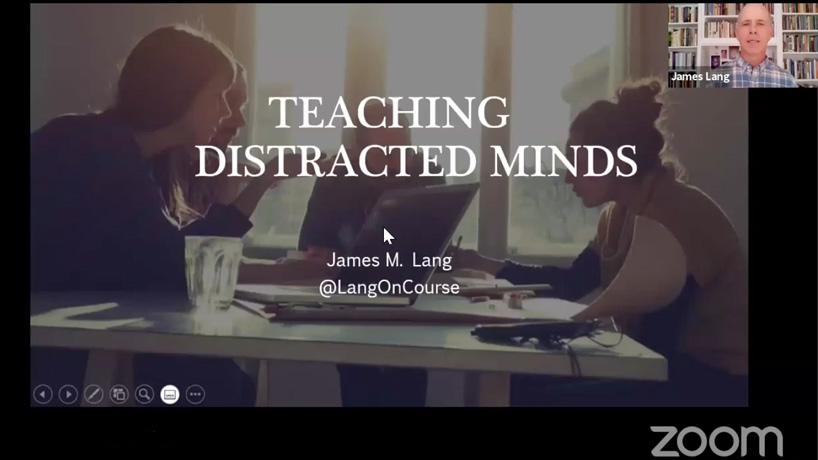
James Lang, a professor of English and director of the D’Amour Center for Teaching Excellence at Assumption University, delivered the keynote address at last week’s Focus on Teaching and Technology Conference. Lang discussed the challenge of teaching distracted minds. (Screenshot)
James Lang was sharing thoughts from his forthcoming book “Distracted” while delivering the keynote address at last week’s Focus on Teaching and Technology Conference at the University of Missouri–St. Louis.
Lang, a professor of English and director of the D’Amour Center for Teaching Excellence at Assumption College, found himself confronting the very challenge at the book’s core: holding students’ attention.
The annual two-day conference, marking its 19th year, took place in a virtual format for the first time because of the COVID-19 pandemic. So, as Lang spoke into a webcam from his home in Worcester, Massachusetts, he was trying to maintain the focus of an audience of more than 1,200 educators, most of them in higher education, spread around the globe.
“Not only is it our challenge to sort of capture and sustain student attention, but that challenge is made difficult by the fact that attention is a limited capacity resource,” Lang said early in his presentation. “We’ve all experienced this on our Zoom calls and in our everyday lives – I’m paying attention to this, I’m not paying attention to that –as well the fact that attention fatigues over time and that attention is more difficult to pay in certain kinds of contexts.”
That’s why Lang implored his audience to, as Northern Arizona University psychologist Michelle Miller argues, think of themselves as “stewards of our students’ attention” and set out to design learning experiences accordingly.
Over the course of the 90-minute webinar – the video of which was shared with C-SPAN for a future broadcast – Lang offered some ideas to help educators better engage with their students and combat attention fatigue.
The message seemed particularly prescient amid a pandemic that has forced so much instruction to take place virtually over the past six months, but Lang began thinking through these challenges long before it began.
The same could be said of the conference itself, which was held in partnership with colleges and universities from across the St. Louis region and Missouri and as far away as Murray State University in Kentucky.
It has never seemed more important for educators to implement technology into their teaching, but the presentations made over two days were rich in ideas applicable at any time.
“We talk about our conference being a focus on teaching and technology, but I think everybody always jumps to that technology portion,” said Jennifer McKanry, the assistant director of UMSL’s Center for Teaching and Learning and the co-director of this year’s conference. “We also try to focus on teaching pedagogy and helping introduce people to different concepts around best teaching strategies, whether it incorporates technology or not.”
The conference has grown significantly over the past decade.
Keeta Holmes, UMSL’s assistant vice provost for academic innovation and the director of the Center for Teaching and Learning, recalled her team being ecstatic to top 200 registrants when she first arrived at UMSL. By 2015 and 2016, it drew audiences of 500 educators or more.
Last year, more than 700 attended the event at the J.C. Penney Conference Center.
The virtual format allowed organizers to expand the reach even farther this year, with sponsorships allowing it to be held at no cost to registrants.
It didn’t hurt that the conference was listed on several websites promoting opportunities related to teaching with technology.
“I think teaching with technology has never been more important, and in particular, our focus on engaging students with technology,” Holmes said. “It’s not just throwing fun tools into the mix. It’s really strategically using the right tool for the right types of courses to support learning for students in ways that are really meaningful.”
As usual, this year’s registrants worked in a wide range of disciplines, including dentistry, optometry, pharmacy, chemistry, microbiology, sociology, business, psychology and mathematics.
There were affinity rooms and other opportunities set up for educators to network with others in their fields.
Some of the sessions were designed for beginners, who might be new to teaching or learning how to incorporate technology into their courses for the first time. Others were geared toward more advanced instructors trying to remain on the leading edge of classroom trends.
During Thursday morning’s headline event, “Effecting Teaching: Tips from Award Winning Teachers,” attendees got to hear insights and examples illustrating both low- and high-tech ways to hold the attention of students and keep them focused on learning.
There were also at least eight sessions, including Lang’s keynote, directly applicable to teaching during the pandemic.
“I think the focus on student learning and using tools strategically has always been a draw for this conference, but it is so timely now,” Holmes said. “I think everyone’s sort of grasping for not just the tech tools but really how to use the tech tools and leverage them to keep students on track toward their degree.”














